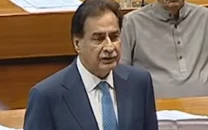What is the MPO – the rules under which Afaq Ahmed is being detained?
MPO is a 90-day detention order issued by district magistrate or government authority often against political rivals.

What is the MPO – the rules under which Afaq Ahmed is being detained?
"The MPO essentially violates Articles 4 and 25 of the Constitution of Pakistan which guarantees liberty and freedom to citizens," said senior lawyer Shaukat Hayat, while commenting to The Express Tribune.
For the detention order to be issued, a district magistrate or any government authority can send a reference, supported by material, that is accepted or rejected by the government. The home department then issues the detention orders that need to be served to the actual person. But after 90 days, a board has to re-examine the material. The detained person can then be released on bond and the surety of good behaviour.
The MPO was promulgated in the Ayub era and was used against political opponents, Hayat added.
The MPO is legal and is even used in the US, added former judge Syed Mehmood Alam Rizvi.
Instead of illegal detention or people going missing, it is better to detain them under the MPO as the detainee can question his detention.
Abu Bakar Zardari, a close aide of President Asif Ali Zardari, is one victim of the MPO and was released only after the SHC permanently restrained the authorities from detaining him under the MPO. "It was always used against politicians," he said.
As the SHC judge only passed an observation and not an actual order that Afaq should not be detained, it was still legal to apply the MPO.



















COMMENTS
Comments are moderated and generally will be posted if they are on-topic and not abusive.
For more information, please see our Comments FAQ